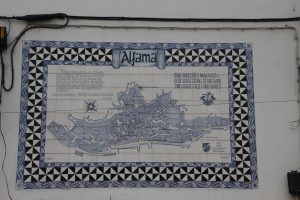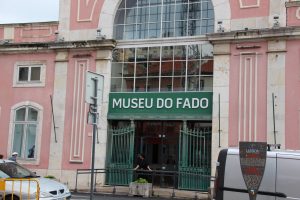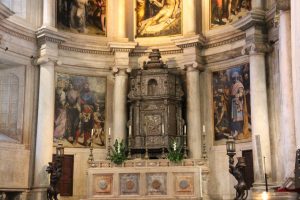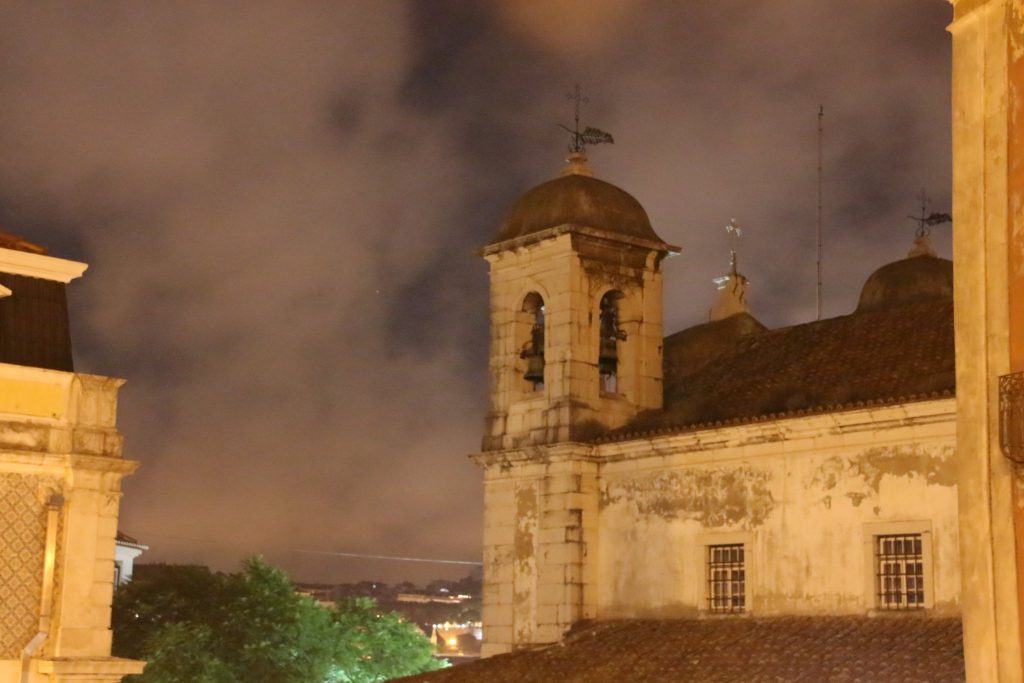October 8th
We have had a couple of enjoyable days as we have discovered more of Lisbon.
After our introduction to some of the neighborhoods on Monday we felt comfortable wandering around. On Tuesday morning we headed down to Praça da Figueira (English: Square of the Fig Tree) and had another version of the local treat called pastels de nata. These are basically the same as the pastels de Belém, but not quite as good. We ate at a pasteleria that has been in business since 1829 and is still very popular. From there we went to the Bairro Alto district to visit a store we had seen on our Monday tour. While Patricia was inside I watched 3 men set up their chestnut roasting operation outside the store. Roasted chestnuts are popular here (as in Istanbul) and you can see clouds of smoke from the burners in many places. Isabel told us that it was early in the season, but I saw lots of people lining up to get paper cones of hot chestnuts.
We stopped in an old bookstore. How old?, you ask. The Bertrand bookstore was opened in 1732. It is 282 years old. The original building was destroyed in the 1755 earthquake, but it has been in its current location since 1773. It is surprisingly modern inside with room after room of books on various subjects. Alas, no books on textiles.
Now we went down the hill–did I mention that Lisbon has 7 hills, like Istanbul, Rome, and San Francisco–, across a couple of squares, and back to our neighborhood where we climbed the 138 steps (but who’s counting?) to our street and the 32 steps to our apartment. All of the steps are manageable, but it was warm and the humidity was in the 80s so we were damp by the time we got inside.
In the afternoon we found our way to the Museu de Fado which involved navigating the twisting streets of the Alfama district. This is the oldest section of Lisbon and at one time was the entire city outside the castle walls. We went left, right, up, and down and finally popped out of a small street at the door to the Museum.
If you don’t know much about fado music, here is a quote from the Wikipedia: “ fado is a form of music characterized by mournful tunes and lyrics, often about the sea or the life of the poor, and infused with a characteristic sentiment of resignation, fatefulness and melancholia (loosely captured by the word saudade, or “longing”)”. It is very popular here and both Patricia and I like it a great deal. The Alfama district has many food/fado places but performances don’t begin until after 11:00 so I don’t know if we will get to one. I am not sure I want to try to navigate the Alfama streets at 2:00 in the morning.
The museum was quite interesting and was full of history about fado (fa-doo) and even had a place where you could explore archives about famous people AND listen to track after track of historical and modern fado music. Needless to say, we spent a lot of time in the Museu.
By this time, something wet and cold sounded like a good idea. We found our way to the Lisbon Hard Rock Café for a late lunch and a cool drink. That involved finding our way out of the Alfama and down to the Praça do Comércio near the Tagus riverfront before turning up Augusta Street, now a pedestrian shopping area, to Rossio Square and up the Avenida de Liberdad.
When we left the Hard Rock, Patricia decided that we needed to head back to the Chiado square area because she had left the store this morning without buying everything she needed. We went up and down and up some more before returning to the apartment for a relaxed evening.
A word about the apartment: it is sort of like visiting the home of an eccentric relative. It is OK, but there are some conditions that may be a little odd and things you might do differently.
On Wednesday we went back out to the Belém district because when we were there on Monday the museums and the church were closed. We managed to find the right trolley and we enjoyed the trip out because it was not too crowded.
The trolley stop is right across from the Pasteis de Belém, which is where we had our first taste of Pastels de Belém on Monday, so we stopped in for a little breakfast before visiting the Jerónimos Monastery. The Monastery church was a place that sailors would visit at the beginning and end of sea voyages. It is designed in the Manueline style which incorporates decorations related to seafaring. Its construction was financed by a tax on goods coming from Africa and India. The new building replaced a much smaller church. The Jerónimos Monastery is a popular attraction and even early in the day it was very busy.
The Cloisters of the monastery are also a popular attraction but we did not wait in the long line to get in. Instead we went to the west end of the large building and visited the Maritime Museum (Museu de Marinha).
It is a very nice museum with many examples of Portuguese naval history. Portugal, of course, was very important as an explorer of the oceans and far-away lands in the 15th, 16, and 17th centuries. We saw model ships, navigational instruments, canon, armor, and other items related to exploration. The halls are huge and we looked at an entire wing devoted to the history of fishing and to Portuguese colonies in Africa. In yet another hall we saw royal barges dating back as far as the 1700s.
One of the items we really liked was a display of the Santa Cruz airplane that made the first crossing of the South Atlantic in 1922. There were actually 3 planes with that name because the crossing took a long time. We had seen a monument to the crossing on Monday and it was nice to see the plane that made the trip.
When we left the museum we were caught in a river squall (I can use a term like that because I was just in a maritime museum) that got us wet before we could get our umbrellas out. We still managed to get over to the Monument to Discovery where we took pictures of the large map that showed important Portuguese sailing expeditions.
The tram back was crowded and hot. We were glad to take a break at home after climbing the steps and finding a street with a more-or-less gentle incline to our apartment.
This evening we went to a restaurant called Chapito which is up the hill from us. Our table was outside with a nice view and we had an enjoyable meal. Patricia tried a local cod dish called bacalhau (salted cod) which is the national dish of Portugal. Now most of the cod comes from Norwegian fishers. Patricia isn’t sure she would have baclhau again. Chapito is an ideal place to get a good look down to the river at night.
When I say “up the hill” I am reminded of our time in Seattle when I became convinced that due to some topological quirk anyplace we went in Seattle was uphill from us and so was the way back.
More pictures on the Pictures Page.




